The first Chinese SSBN: It is well understood today that the most efficient deterrence carrier today is the SSBN (for ‘submarine’ ‘ballistic missile’ ‘nuclear powered’). Only five nations in 1987 could boast having that capability: USA, USSR, UK, France and that Year, the popular republic of China. That was a milestone in Chinese rise to power in Asia, before both India and North Korea joined the fray (Arihant and Sinpo classes), before, most probably Pakistan in a not distant future (Five Chinese-assisted SSGs for 2028). The Xia-class remained the first SSBN designed and built in Asia.

Xia class underway – Src
However the Type 092 submarine came not as a complete surprise to the Western world: The type was known in construction at Bohai Shipyard, Huludao thanks to satellites in 1983-84 already. The conspicuous missile caps were clearly visible behind the fin. And boat 406 was laid down in 1978 (antoher source precised September 1970) to be completed in 1981 but operational in 1987, showing the very large span of construction and ambitious task expressed by Chairman Mao in the 1960s after the Sino-Soviet split. Without external assistance for a country barely out of its internal turmoil caused by the “little red book”, this was not, like the previous Type 093 SSNs (Han class), a small engineering feat.
And indeed the SSN class proved a great basis to start with, despite its limitations. Half of the work was done already, the rest revolving around the fitting of a new section containing ballistic tubes for underwater launch. In fact, only 15% of new fittings and systems were developed. Although riddled with problems and limitations, this “protototype” helped setting a safe board on which was designed the next ‘Jin’ class (Type 094) SSBNs from the 2000s. Almost 20 years of lessons helped the design of the modern Chinese SSBNs. The next step in the 2020s will be the Type 096 SSBNs (SUI class ?). NATO “Xia” class is a reference to the first known semi-legendary Imperial dynasty of China (founded by Yu the Great around c. 2070 BC, the Chinese Bronze age).
Development of the Type 092
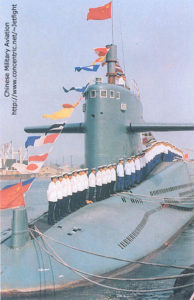 Although Mao’s will dated back the 1950s (“We will have to build nuclear submarines even if it takes us 10,000 years“), it was on July 1958 that the party officially approved the development of nuclear propulsion and ballistic missiles. Several steps ensured the Type 092 was possible: First, the construction and setup of a nuclear submarine plant at Bohai, Huludao (190 km (120 mi) northeast of Beijing). Second, the construction of the first Chinese land-based nuclear reactor from 1965. Third, expertise gained in the making of the Type 91 by the team led by Huang Xuhua for the prototype “Long March” between 1970 and 1977.
Although Mao’s will dated back the 1950s (“We will have to build nuclear submarines even if it takes us 10,000 years“), it was on July 1958 that the party officially approved the development of nuclear propulsion and ballistic missiles. Several steps ensured the Type 092 was possible: First, the construction and setup of a nuclear submarine plant at Bohai, Huludao (190 km (120 mi) northeast of Beijing). Second, the construction of the first Chinese land-based nuclear reactor from 1965. Third, expertise gained in the making of the Type 91 by the team led by Huang Xuhua for the prototype “Long March” between 1970 and 1977.
Logically the next design started right alongside and a bit posterior to the type 091 development, design work started probably around 1975-76, by Peng Shilu and Huang Xuhua. They focused right away on an “extended” version of the Type 091 for accomodating an extra row of ballistic tubes.
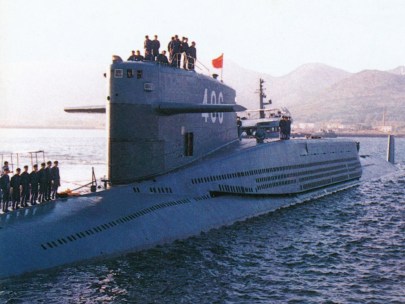
Design
The basic teardrop design was the same as the Type 091 SSN, but with a 22 m section installed behind the fin (conning tower). This section accomodated twelve tubes, enclosed with a standard outwards opening single piece cupola hatches. Each silo housed a JL-1A SLBMs. Tne hull measured therefore 120 m, quite an increase compared to the Han class, whereas the width and draft were unchanged. Tonnage however jumped from an estimated 8,000 tons, 3,500 more than the original ship. The lead shielding of the nuclear core confinment zone also added to this tonnage.
Powerplant
It was the same as the Type 091, still a pressurized-water nuclear reactor, but it was larger, producing 58 to 90 MegaWatts, and fed two steam turbines whereas the Han class had a turbo-electric engine. Both turbines were mated, via a system of gears, to a single 1 shaft. There is another source () which claimed that these were turbo-electric units instead. This was sufficient to produce a lower standard top speed of 22 knots (41 km/h; 25 mph), far less than the 25 knots (46 km/h) of the Han class, and with the same level of noise. All the power was passed onto a single four-blade propeller.
Armaments
The self-defence of the Type 092 was assured by six 533 mm torpedo tubes, in the same bow configuration as the type 091. The torpedoes were of the Yu-4B type, derived from the Russian SAET-50 passive acoustic homing torpedo. After the Sino-soviet-split it was further developed by Northwestern Polytechnical University, Xi’an & Pinyang, instrumentation being provided by the East Wind Instrumentation Factory,Xi’an (only Yu-4A), and the model produced by the Machinery Factory, Houma, Shanxi. The submarine’s navigation systems (initial, stellar and satellite) was developed by Tianjin-based 707 Institute.
Type Yu-3 At first the Type 92 was given 12 torpedoes of this type. The Yu-3 was the standard acoustic homing torpedo designed to be fired from submarines (service in 1983). Its development went back from 1965 and it is probably the first indigenously developed torpedo in China. It was 7.8 meter long for 1.34 ton and carrying a 205 kg warhead. It was propelled by an electrical unit with a silver-zinc battery, capable of reaching 13 km at 35 kt, and could fired in the dephts, down to 400 metre. The ET32 is a 2009 modernized version. This model replaced the Yu-1 on board (first model fitted) or type 53-51, and unguided vector to 9.2 km at 39 kt or 3.7 km at 51 kt with a warhead 400 kg.
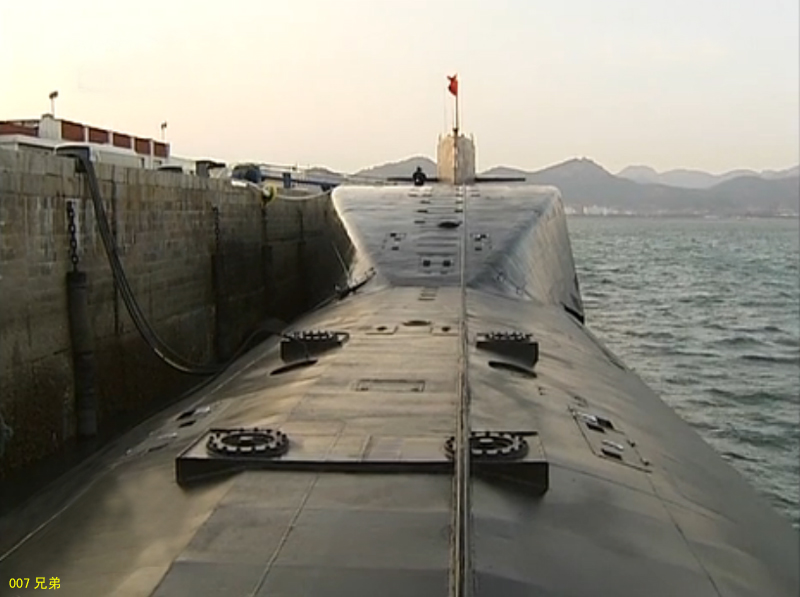
Stern view of the Xia class. Src: http://chinesemilitaryreview.blogspot.com
Type Yu-4B weights 1,775 kg (1,628 kg for the training version), for 7.75 m long x 0.53 m diameter.
The Warhead weighted 309 kg. t was propelled by an electrical, silver-zinc battery engine, with a 6 km (original) range at 30 knots (56 km/h).
The upgraded 4B version was able to reach 15 km (upgraded) at 40 knots (74 km/h).
Its Guidancesystem comprised an acoustic homing, active/passive.
As the tube chamber and whole prow section are similar, it is likely that they can carry also 36 mines in their tubes.
The complex underwater missile launch system was designed and developed by Wuhan-based 713 Institute.
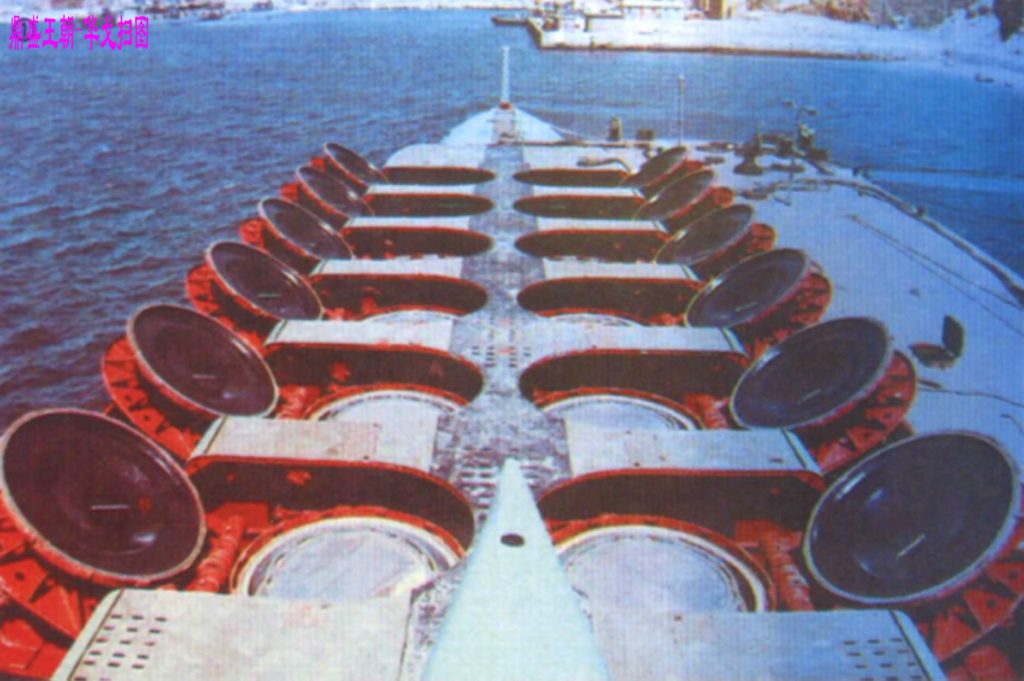
Ballistic Tubes caps open – Xia class – Src: https://www.defencetalk.com
Juland JL-1A
This ballistic missile was produced by Factory 307 (Nanjing Dawn Group). Name: Jù Làng Yī; literally: ‘Huge Wave-1’. NATO CSS-N-3. It was the first Chinese SLMB, designed by Huang Weilu, and Chen Deren. Research and development went back to 1967. Design was refined in the early 1970s, for a production starting after the first succesful launch on 30 April 1982. This was made on an “expendable” platform, a PLAN’s modified Golf class SSB.
The JL-1 weighted 14,700 kilograms (32,400 lb), for a total height of 10.7 metres (35 ft) and diameter of 1.4 metres (4.6 ft). The nuclear warhead carried had a blast yield of 250-500Kt.
The rocker propellant was Solid fuel, and it was capable of a 1,770 km (JL-1), 2,500 km (JL-1A) range. Its Guidance system was Inertial. It allowed an accuracy of 600 m CEP.
The first launch on land was made in 1981, the first from a submarines (modified Gold class) in October 1982 and the first launch by the Xia-class on 15 September 1987.
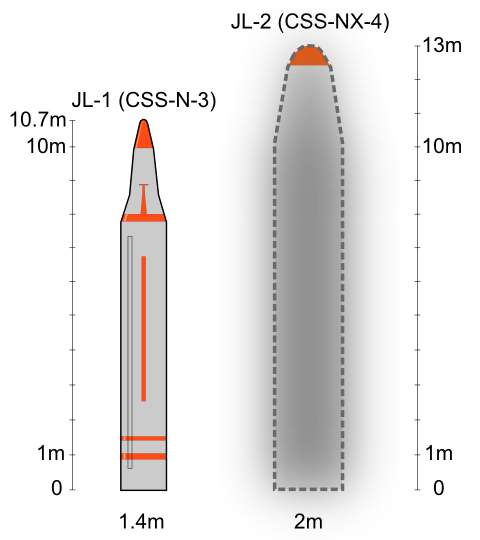
Electronics and systems
> Multi-purpose combat data/command system for submarine control and weapons management
> SLBM integrated Fire-control system
> Surface search radar (NATO ‘Snoop Tray’), I-band type
> Type 603/604 bow-mounted, medium-frequency sonar for (active & passive search)
> Chinese version of the French DUUX-5 low frequency sonar, passive ranging, interception
> Type 921-A radar warning receiver/direction-finder
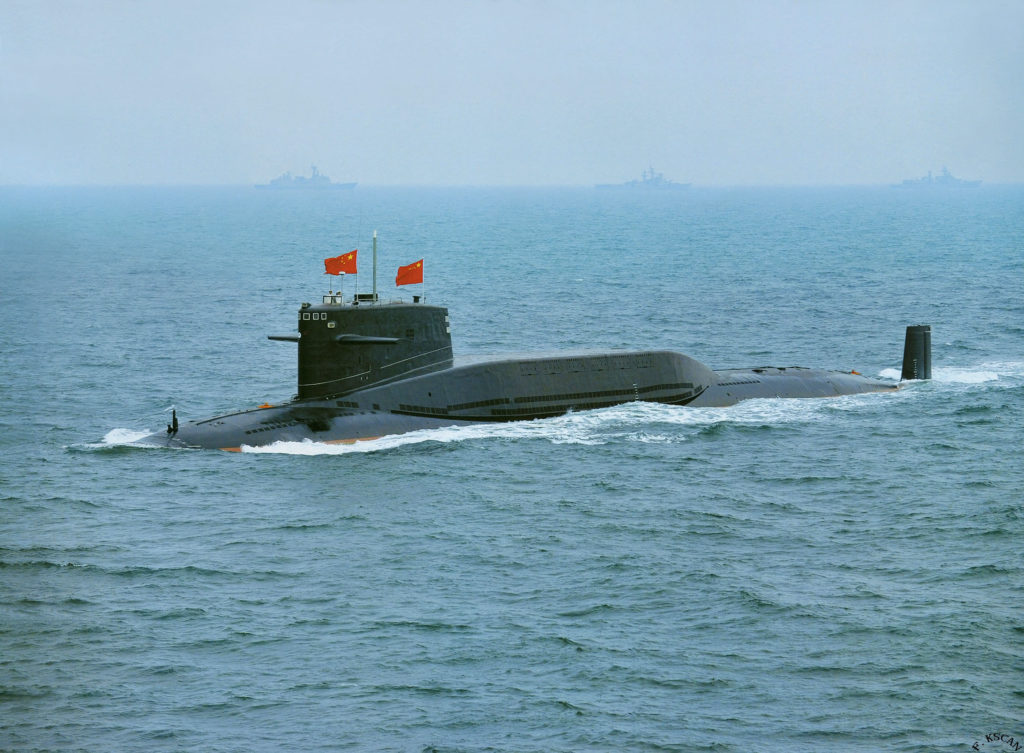
Very large pic of the Type 092 – SRC
Active life as a testbed 1987-2000s
After launch, the Type 092 Daqingyu (Chinese designation 09-II) spent six years in fittings, modifications and counter-fittings. The program of modernisation started in 1995 to end in 2001. She conducting intensive testing campaigns notably around fake and real JL-1 missile firings. She became as a result active only by 1987. Afterwards, the submarine had many upgrades in incremental steps.
-Type H/SQ2-262B sonar (No.613 Factory)
-French designed sonar
The Type 604 sonar suffered from limited missile range and high sound emissions.
-New black paint, possibly acoustic-absorbent coating
-JL-1A SLBM: Longer range ballistic missile
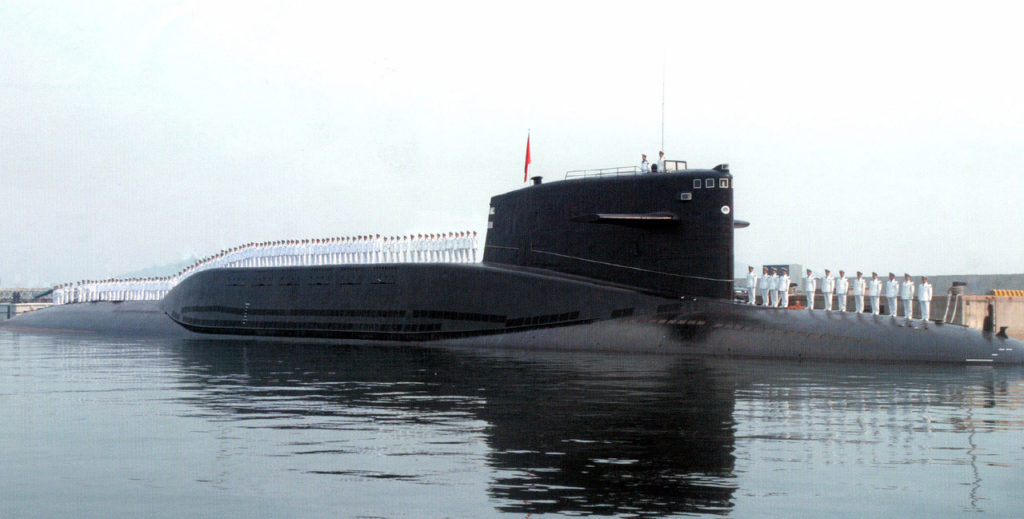
Xia class and crew in review – Src whitefleet.net
The submarine became “operational” in 1983 (but commissioned in 1987). It was reported facing long lasting teething problems. These were linked with the level of reliability and radiation leakage from the nuclear reactor. Also, the ill-fated Type 091 “Han” class on which she was based, she is well-known as the noisiest SSBN in service back then. It was very easy to detect and track, rendering the whole proposition of bringing a SSBN in firing position in a war scenario very hazardous indeed. This put the whole deterrence process in jeopardy.
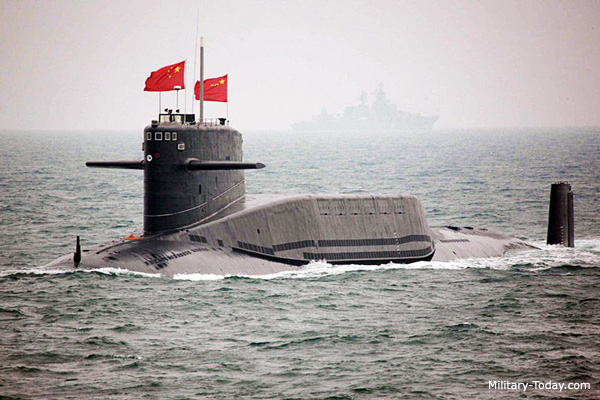
In service, her homeport was in Jianggezhuang, near Qingdao. According to NATO, the Type 092 never went into a standard strategic patrol outside Chinese regional waters. A single long range patrol was made in Chinese territorial waters, and the submarine apparently never sailed again. She has been spotted by satellites pierside and at some point disappeared, raising a rumor about her catching fire and sinking in 1985, so before even her official commission. In conclusion, the Type 092 was a test bed, a prototype allowing the test of new underwater technologies and paving the way for the development of the second generation Chinese SSBNs. The Type 094 in between reached construction and completion stage, whereas the U.S. Defense Intelligence Agency official report of the Type 092 is “not operational.” The unique Xia class boat was made known worldwide on 23 April 2009 during the jubilee of the 60th anniversary of the PLA Navy.

Changzheng 6 (# 406) profile, as built.

Changzheng 6 as modernized in the 1990s. It is generally believed that the paint scheme is an anechoic materials assembly, making her less noisy overall.
Xia class Specs as commissioned (1987) |
|
| Dimensions | 120 m (393 ft 8 in) x 10 m (32 ft 10 in) x 8 m (26 ft 3 in) |
| Displacement | 6,500 to 8,000 long tons underwater (estimations) |
| Crew | 100 to 140 (estimations) |
| Propulsion | 1 shaft pressurized-water nuclear reactor, 58MW, 2 × steam turbines |
| Speed | 22 knots (41 km/h; 25 mph) |
| Range | Unlimited (crew endurance and food supplies) |
| Armament | 6 × 21-inch (533 mm) TTs bow, 12 JL-1A SLBMs. |
Read More/Src
Connway’s all the world’s fighting ships 1947-95
Erickson, Andrew; Goldstein, Lyle (2007) “China’s Future Nuclear Submarine Force: Insights from Chinese Writings” (PDF).
//www.hisutton.com/Nuclear%20Missile%20Submarines.html
//chinapower.csis.org/ssbn/
//en.wikipedia.org/wiki/Type_092_submarine
//www.globalsecurity.org/wmd/world/china/type_92-line.htm
//fas.org/nuke/guide/china/slbm/type_92.htm
//www.defencetalk.com/military/images/c/type-092-xia-class-china.3658/
//ssgmilitary-defence.blogspot.com/2011/08/092-submarine-military-defence-of-china.html
//sinodefence.com/type-092_xia-class/
//www.icsin.org/publications/understanding-chinas-submarine-capabilities-undersea-competition-in-the-indo-pacific
//news.usni.org/2015/01/15/stratcoms-haney-china-not-transparent-nuclear-weapons-policy
//chinesemilitaryreview.blogspot.com/2011/12/chinese-type-092-xia-class-nuclear.html
//news.usni.org/2015/01/15/stratcoms-haney-china-not-transparent-nuclear-weapons-policy
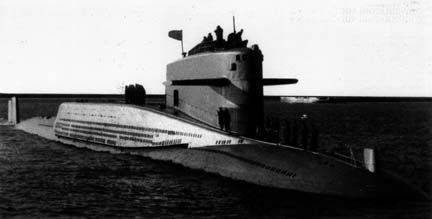



 Latest Facebook Entry -
Latest Facebook Entry -  X(Tweeter) Naval Encyclopedia's deck archive
X(Tweeter) Naval Encyclopedia's deck archive Instagram (@navalencyc)
Instagram (@navalencyc)





 French Navy
French Navy Royal Navy
Royal Navy Russian Navy
Russian Navy Armada Espanola
Armada Espanola Austrian Navy
Austrian Navy K.u.K. Kriegsmarine
K.u.K. Kriegsmarine Dansk Marine
Dansk Marine Nautiko Hellenon
Nautiko Hellenon Koninklije Marine 1870
Koninklije Marine 1870 Marinha do Brasil
Marinha do Brasil Osmanlı Donanması
Osmanlı Donanması Marina Do Peru
Marina Do Peru Marinha do Portugal
Marinha do Portugal Regia Marina 1870
Regia Marina 1870 Nihhon Kaigun 1870
Nihhon Kaigun 1870 Preußische Marine 1870
Preußische Marine 1870 Russkiy Flot 1870
Russkiy Flot 1870 Svenska marinen
Svenska marinen Søværnet
Søværnet Union Navy
Union Navy Confederate Navy
Confederate Navy Armada de Argentina
Armada de Argentina Imperial Chinese Navy
Imperial Chinese Navy Marinha do Portugal
Marinha do Portugal Mexico
Mexico Kaiserliche Marine
Kaiserliche Marine 1898 US Navy
1898 US Navy Sovietskiy Flot
Sovietskiy Flot Royal Canadian Navy
Royal Canadian Navy Royal Australian Navy
Royal Australian Navy RNZN Fleet
RNZN Fleet Chinese Navy 1937
Chinese Navy 1937 Kriegsmarine
Kriegsmarine Chilean Navy
Chilean Navy Danish Navy
Danish Navy Finnish Navy
Finnish Navy Hellenic Navy
Hellenic Navy Polish Navy
Polish Navy Romanian Navy
Romanian Navy Turkish Navy
Turkish Navy Royal Yugoslav Navy
Royal Yugoslav Navy Royal Thai Navy
Royal Thai Navy Minor Navies
Minor Navies Albania
Albania Austria
Austria Belgium
Belgium Columbia
Columbia Costa Rica
Costa Rica Cuba
Cuba Czechoslovakia
Czechoslovakia Dominican Republic
Dominican Republic Haiti
Haiti Hungary
Hungary Honduras
Honduras Estonia
Estonia Iceland
Iceland Eire
Eire Equador
Equador Iran
Iran Iraq
Iraq Latvia
Latvia Liberia
Liberia Lithuania
Lithuania Mandchukuo
Mandchukuo Morocco
Morocco Nicaragua
Nicaragua Persia
Persia San Salvador
San Salvador Sarawak
Sarawak Uruguay
Uruguay Venezuela
Venezuela Zanzibar
Zanzibar Warsaw Pact Navies
Warsaw Pact Navies Bulgaria
Bulgaria Hungary
Hungary

 Bundesmarine
Bundesmarine Dutch Navy
Dutch Navy Hellenic Navy
Hellenic Navy Marina Militare
Marina Militare Yugoslav Navy
Yugoslav Navy Chinese Navy
Chinese Navy Indian Navy
Indian Navy Indonesian Navy
Indonesian Navy JMSDF
JMSDF North Korean Navy
North Korean Navy Pakistani Navy
Pakistani Navy Philippines Navy
Philippines Navy ROKN
ROKN Rep. of Singapore Navy
Rep. of Singapore Navy Taiwanese Navy
Taiwanese Navy IDF Navy
IDF Navy Saudi Navy
Saudi Navy Royal New Zealand Navy
Royal New Zealand Navy Egyptian Navy
Egyptian Navy South African Navy
South African Navy






























 Ukrainian Navy
Ukrainian Navy dbodesign
dbodesign